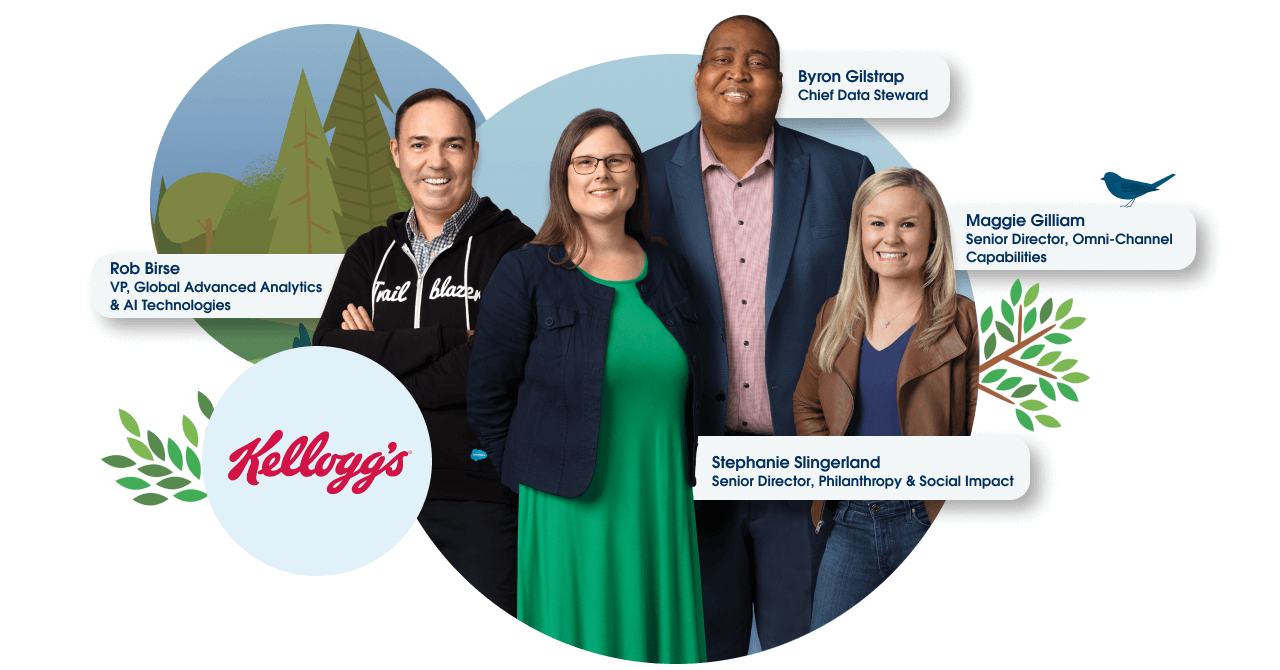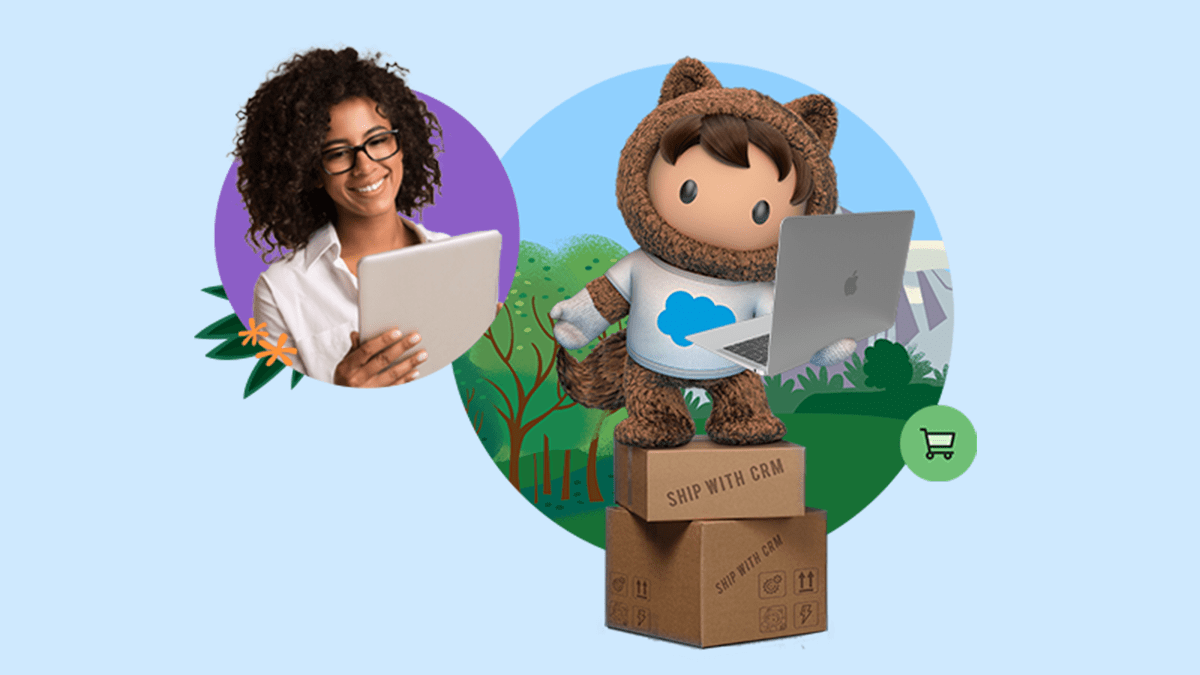Ordering snacks? Kellogg can fill your cart for you, thanks to data.
Learn how Kellogg suggests products that maximize shelf revenue for its retail customers.
W.K. Kellogg changed breakfast forever when he invented the flaked cereal we now know as Corn Flakes in 1894. Since then, the Kellogg Company has been a leader in the category with wholesome cereals and snacks in stores around the world.
To engage deeper with consumers and B2B customers of every size, Kellogg puts advanced analytics at the center of its thinking. Rob Birse, Vice President of Global Advanced Analytics, AI, and B2B Ecommerce, believes data is the fuel that will help the company scale and achieve near-real-time engagement with customers.
With data built into commerce processes, Kellogg can suggest products that help smaller customers such as rural stores maximize shelf revenue. It can reach consumers directly and route trends and feedback to Kellogg food techs and engineers. And it can care for the community with donated meals and an online hub of opportunities for employees to volunteer their time and money.
Let’s take a look at how Einstein 1 helps Kellogg wow its customers.
1. Use AI to meet the needs of mom-and-pop stores, too.
Kellogg is no stranger to big box chains around the world. But small format stores are also a key revenue driver. Until recently, it was difficult for sales reps to build relationships with these mom-and-pop stores in remote locations. Kellogg wanted to provide B2B customers with helpful, store-specific insights while giving its sales teams time to focus on key priorities.
- First, Kellogg launched a mobile ecommerce storefront for distributors to sell directly to small-format B2B customers.
- It then used AI to examine purchasing patterns for stores with similar locations, sizes, order histories, trending products, and customer bases. With dynamic segmentation built in, Kellogg could automatically group similar stores together when demand shifted. A convenience store with a new hospital across the street will see tremendous changes in demand compared to more remote locations.
- A “Suggested Order” section pre-populates in customers’ carts with the optimal store product mix based on their grouping. The AI can then proactively make educated guesses about the stores’ ideal assortment to help them maximize shelf revenue.
“The AI makes recommendations at a scale of thousands per minute — something a human or a traditional sales or marketing engagement model could never do,” said Birse.


Rob Birse shares three B2B industry observations:
- Hypersegmentation is coming. As brands gain access to intelligent insights, they can create customized foods for high potential consumer segments, such as those who value gut health or allergen-free ingredients.
- B2B marketplaces are the future. Kellogg joined forces with other major brands to extend its points of sale around the world. Marketplaces allow store owners in emerging markets to stock up on products in one place.
- Serve long-tail customers. Long-tail customers operate in the dark compared to big omnichannel retail chains. Democratizing technology and data can bring a new level of intelligence to each store, allowing it to measure performance and act on trends to provide a better shopper experience.
AI also plays an important role in Kellogg’s “shelfie program,” an innovative program that involves crowdsourcing consumers to do work that ultimately benefits the community. Here’s how:
- Kellogg enlists the help of shoppers and gig workers to take snapshots of in-store end caps and shelves.
- Participants then upload the photos through a third-party app, helping Kellogg identify low- and out-of-stock products and monitor retailers’ shelf setup compliance.
- Kellogg then issues a reward — not in money or prizes, but in meals back to the community. Through its company-wide Better Days program, Kellogg works directly with food banks to turn shelfie participant reward points into meals in the store’s region.
- The program may even generate a little friendly competition between stores with promotional signs that encourage shoppers to participate.
Having this data allows Kellogg to take action when products aren’t displayed as expected. If a shelfie reveals products that were sourced outside of authorized Kellogg channels, the company can alert distributors to strengthen retailer relationships and adjust the store’s purchased assortment.
The B2B Digital Commerce Playbook
Research suggests 80% of business buyers expect to conduct more business online. But when faced with so many competing priorities, just getting started can be a challenge. Whether you’re starting from scratch or replacing an aging legacy platform, you need proven steps to get your digital storefront up and running. The B2B Digital Commerce Playbook helps you:
- Build a long-term plan for digital commerce
- Align cross-functional teams
- Secure buy-in
- Launch your digital storefront faster
Sign up once and unlock all our resources.
2. Test concepts and trends with DTC relationships.
Kellogg then built on its existing cross-channel technology to create a complete commerce engine that included direct to consumer (DTC).
“We already have this technology that’s shared across engagement channels, so why not build on something you already have?” said Birse. “We have an entire commerce engine on Salesforce B2B Commerce.”
Yet, while DTC builds relationships, a consumer’s purchase of one or two items isn’t enough to drive large volume sales. One of the ways Kellogg builds cart volume is with a “headquarters” site for its Cheez-It brand. Cheez-It HQ lets fans buy merchandise from apparel to snacks, increasing basket size and building brand ambassadors.

Kellogg is also building an insights engine on top of the commerce platform to converse with consumers on new products. Consumers can interact with Kellogg’s food techs and engineers to test and review new product concepts. Plus, Kellogg will have a new consumer audience to sell to.
Birse believes consumers also play a big role in determining regional demand. In what he calls “online to offline” retail, data from online actions like social listening could identify shifts in consumer conversations that translate into offline responses. If a morning news program on high-fiber breakfasts suddenly boosts chatter about Special K in a particular region, Kellogg wants to have the data to share with stores and shift those products to the front.
“There’s no end to the list of use cases data can be applied to,” said Birse. “Anything at all can be converted into a shoppable action that might align with a consumer trend or desire.”
3. Feed the community and nourish the world.
Kellogg is a purpose-driven organization, striving to create a world where people aren’t just fed, but fulfilled. With this legacy in mind, Kellogg is addressing wellbeing, hunger, sustainability, and equity, diversity, and inclusion to advance sustainable and equitable access to food, creating Better Days for 3 billion people by the end of 2030. The Better Days Hub, powered by Philanthropy Cloud, provides a centralized place for Kellogg to:
- Post new volunteer opportunities for employees looking to give back.
- Learn what causes, activities, and funds employees are most interested in.
- Encourage employee donations to any nonprofit or campaign, not just its own.
- Identify champions to help create compelling content for fellow employees.
The vast majority (80%) of Kellogg employees find the platform user-friendly and similar to consumer apps. The hub also provides data that program leaders can use to deepen employee engagement in philanthropy.
“We have access to so much more rich and robust data that we didn’t have before,” said Stephanie Slingerland, Senior Director of Philanthropy and Social Impact at Kellogg.

Kellogg also focuses on sustainability by minimizing waste. The OMS helps the company remarket unclaimed products to the customers that are most likely to buy them. Bulk stores and closeout retailers can even purchase these products and visualize their order on a single truck to maximize efficiency and prioritize sustainability. Instead of shipping from across the country, products are sourced from the closest distributor possible.
“This is a great example of a much more sustainable process,” said Birse. “OMS will be front and center doing that for us going forward.”
Better Days was especially important during the pandemic, when it was more difficult to help children facing hunger in person. In response, Kellogg donated $7.5 million in food and funds to global COVID-19 hunger relief efforts, including Michigan children who would normally receive free lunch at school.
After pioneering the cereal and snack world for nearly 130 years, Kellogg has its sights set on trailblazing a new industry era. In partnership with Salesforce, Kellogg aims to change how all consumer goods companies interact with their networks.
“We’re working together to help find commercially viable solutions that change the industry’s approach to creating value,” said Birse.
Get our bi-weekly newsletter for tips and insights tailored to your role.
Ready to build a single view of your customer?
More Resources

Guide
The State of Commerce

Article
Reimagining Your B2B Ecommerce

Guide
The Manufacturer's Guide to Digital B2B Commerce




